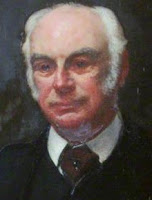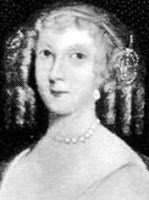 |
| Portal Baronets coat of arms [Argent, a lion rampant sable, on a chief azure, six mullets or, three and three] |
ELIZABETH DRUMMOND, b. 31 Jan. 1788 Westminster, bap. 28 Feb. 1788 St James Church, Westminster; d. 21 May 1877 Knightsbridge, London, bur. 26 May 1877 St Mary Church, Laverstoke, Hampshire, only dau. of Henry Drummond, Heir of The Grange (1762-1794, descended from Henry VII - see Generation A9 below) and Hon. Anne Dundas (1767-1852, descended from James IV - see Generation C10 below); m. 1 Aug. 1815 St Swithin Church, Walcot, Bath, Somersetshire, as his 2nd wife, JOHN PORTAL of Laverstoke House, b. 29 Apr. 1764, bap. 9 Oct. 1764 All Saints Church, Whitchurch, Hampshire; d. 7 May 1848 Freefolk House, Freefolk Priors, Hampshire, bur. All Saints Church, Whitchurch, yst son of Joseph Portal of Laverstoke House, paper mills owner (1720-1793) and Sarah Peachey (d. 1802), and had issue, five sons and two daughters.
 |
| The beginning of Ruvigny's account of the Portals in his 1903 Tudor volume p. 538 |
 |
| Edward Knight (1794-1879) |
1) HENRY JOHN PORTAL, b. 22 Mar. 1817 Westminster, London, bap. 13 Apr. 1817 St Marylebone Parish Church; d. young 22 Sept. 1823 Weston-super-Mare, Somersetshire, bur. 29 Sept. 1823 St Mary Church, Laverstoke.
2) ADELA PORTAL, b. 7 Apr. 1818 Freefolk House; d. 28 June 1870 Chawton House, Hampshire, bur. 4 July 1870 St Nicholas Churchyard, Chawton; m. 3 Mar. 1840 All Saints Church, Whitchurch, Hampshire, as his 2nd wife, EDWARD KNIGHT of Chawton House, b. 10 May 1794 Godmersham Park, Kent, bap. 20 June 1794 St Lawrence Church, Godmersham; d. 5 Nov. 1879 Chawton House, bur. 10 Nov. 1879 St Nicholas Churchyard, Chawton, est son of Edward [Austen] Knight of Godmersham Park (1768-1852, descended from Edward III, er bro of novelist Jane Austen) and Elizabeth Bridges (1772-1808, descended from Edward III), and had issue, four sons and five daughters.
 |
| Melville Portal (1819-1904) |
4) Lt-Col. ROBERT PORTAL of Ashe Park House, Hampshire, 5th Royal Irish Lancers, b. 7 Nov. 1820 Freefolk House, bap. 30 Jan. 1821 St Mary Church, Laverstoke; d. 24 Dec. 1888 Ashe Park House, bur. 28 Dec. 1888 Holy Trinity Churchyard, Ashe; m. 19 Feb. 1856 Christ Church, Cheltenham, Gloucestershire, ELIZA CHARLOTTE SLEECH TAYLOR, b. 17 Aug. 1826 St Johns Wood, Westminster, bap. 29 Sept. 1826 Christ Church Cosway Street, Marylebone, London; d. 19 July 1902 Sherborne St John, Hampshire, bur. Holy Trinity Churchyard, Ashe, yst dau. of Maj-Gen. Thomas William Taylor of West Orwell House, Devon (1782-1854, descended from Edward I) and Anne Harvey Petrie (1786-1858), and had issue, two daughters.
 |
| Evelyn Portal in Ruvigny's 1903 Tudor volume p. 539 |
Issue of Lt-Col. Robert and Eliza (Taylor) Portal:
4A) EVELYN ADELA PORTAL, b. 6 Jan. 1863 Compton Verney House, Warwickshire, bap. 15 Feb. 1863 St Mary & St Margaret Church, Combrook, Warwickshire; d. unm. 11 Apr. 1949 Over Wallop, Hampshire.
 |
| Sir Wyndham Portal, 1st Bt (1822-1905) |
4B) GRACE PORTAL, b. 10 Sept. 1866 Ashe Park House, bap. 28 Oct. 1866 Holy Trinity Church, Ashe; d. young 6 Oct. 1878 Ashe Park House, bur. Holy Trinity Churchyard, Ashe.
5) Sir WYNDHAM SPENCER PORTAL, 1st Baronet of Malshanger, b. 22 July 1822 Freefolk House, bap. 28 June 1823 St Mary Church, Laverstoke; d. 14 Sept. 1905 Malshanger House, Oakley, Hampshire, bur. 18 Sept. 1905 St Leonard Church, Oakley; m. 19 Apr. 1849 All Saints Church, Deane, Hampshire, MARY JANE HICKS-BEACH, b. 9 Sept. 1828 Oakley Hall, Church Oakley, Hampshire, bap. 13 Oct. 1828 All Saints Church, Deane; d. 4 Nov. 1903 Malshanger House, bur. 9 Nov. 1903 St Leonard Church, Oakley, est dau. of Col. William Hicks-Beach of Oakley Hall (1783-1856, descended from Edward III) and Jane Henrietta Browne (1804-1831, descended from Edward III), and had issue, three sons and four daughters.
 |
| St Mary Church, Laverstoke, Hampshire |
6) Rev. GEORGE RAYMOND PORTAL, Rector of Burghclere, Hampshire 1871-89, b. 28 Feb. 1827 Freefolk House, bap. 14 July 1827 St Mary Church, Laverstoke; d. 3 Apr. 1889 Burghclere, bur. 8 Apr. 1889 All Saints Churchyard, Burghclere; m. 26 Dec. 1860 Turin, Italy, HELEN MARY CHARLOTTE (SOULSBY) DAUBUZ, b. Bessingby Hall, Yorkshire, bap. 5 Oct. 1828 St Magnus Church, Bessingby; d. 9 May 1904 South Kensington, London, bur. 12 May 1904 All Saints Churchyard, Burghclere, widow of William Daubuz of Killiow House (1804-1854), and dau. of Christopher Thomas Soulsby of Bessingby Hall (1794-1842, descended from Edward IV) and Anne Hudson (1797-1839, descended from Edward IV), and had issue, three sons and two daughters.
7) JANE ELIZA PORTAL, b. 24 Nov. 1829 Freefolk House, bap. 14 June 1830 St Mary Church, Laverstoke; d. 14 Nov. 1900 Folkestone, Kent, bur. 19 Nov. 1900 Cheriton Road Cemetery, Folkestone; m. 3 Sept. 1863 St Mary Church, Laverstoke, Maj. THOMAS DUNDAS of Belgravia, London, 12th Regiment of Foot, b. 3 May 1825 Arniston House, Borthwick, Midlothian, bap. 26 June 1825 Borthwick Parish Church; d. 20 July 1902 Belgravia, bur. 24 July 1902 Cheriton Road Cemetery, 2nd son of Robert Dundas of Arniston House (1797-1838, descended from James IV) and Lilias Calderwood Durham (1799-1883), and had issue, one daughter.
 |
| James IV |
James IV had three illegitimate daus A1, E1 & G1 (see below)
A1) Lady Margaret Stewart, illegit. (1496-aft.1562) m. 2) Sir John Drummond, 2nd Laird of Innerpeffray Castle (c.1495-aft.1554), and had two daus A2 & C2 (see below)
A2) Jean Drummond (c.1535-1603) m. James Chisholm, 3rd Laird of Cromlix (c.1522-by 1598), and had
A3) JEAN CHISHOLM, b. 13 July 1555; d. Nov. 1589; m. JAMES DRUMMOND, 1st Lord Maderty, b. c.1555; d. Sept. 1623, yr son of David, 2nd Lord Drummond (c.1515-1571) and his 2nd wife Lilias Ruthven (c.1522-1579), and had two sons A4 and B4 (see below)
A4) Sir JAMES DRUMMOND, 1st of Machany House, Blackford, Perthshire, b. c.1585; d. after 1648; m. Mar. 1619, KATHERINE HAMILTON (see E5 below), and had
 |
| Drummond coat of arms |
A6) Sir JOHN DRUMMOND, 3rd of Machany House, b. c.1650; d. 1707; m. MARGARET STEWART, b. c.1660; d. unknown, dau. of Sir William Stewart of Innernytie (c.1612-1672, descended from Edward III) and Mary Crichton, and had
A7) WILLIAM DRUMMOND, 4th Viscount Strathallan, b. c.1690 Machany House; d. (killed in battle) 16 Apr. 1746 Culloden Moor, Inverness-shire, Scotland; m. 1 Nov. 1712, Hon. MARGARET NAIRNE (see B9 below), and had
A8) Hon. HENRY DRUMMOND of The Grange, Northington, Hampshire, partner Drummonds Bank, Charing Cross, London, M.P. Wendover 1774-80, Midhurst 1780-90, b. 7 Feb. 1730 Machany House, bap. 9 Feb. 1730 Blackford Parish Church; d. 24 June 1795 The Grange, bur. 1 July 1795 St John Church, Northington; m. 23 Mar. 1761 St James Church, Westminster, ELIZABETH COMPTON, b. 13 Sept. 1734; d. 25 Mar. 1819 Marylebone, London, bur. 2 Apr. 1819 St John Church, Northington, 4th dau. of Hon. Charles Compton of Northampton (1698-1755, descended from Edward III) and Mary Lucy (b. 1709, descended from Edward III), and had
A9) HENRY DRUMMOND, Heir of The Grange, M.P. Castle Rising 1790-94, b. 13 Jan. 1762 Westminster, bap. 9 Feb. 1762 St Margaret Church, Westminster; d. 4 July 1794 Spring Gardens, London, bur. 11 July 1794 St John Church, Northington; m. 13 Feb. 1786 St Martin in the Fields, London, as her 1st husband, Hon. ANNE DUNDAS (see C10 below), and had
A10) ELIZABETH DRUMMOND (1788-1877-see details above)
 |
| Margaret (née Graeme), Lady Nairne - see Generation B7 |
B4) John Drummond, 2nd Lord Maderty (c.1580-by 1651) m. Hon. Margaret Leslie (b. c.1600, descended from James V), and had
B6) Hon. Jean Drummond (b. c.1625) m. Patrick Graeme, 5th Laird of Inchbrakie Castle (c.1610-1687, descended from James II), and had
B7) Margaret Graeme (c.1644-1704) m. Robert, 1st Lord Nairne (c.1620-1683), and had
B8) Hon. Margaret Nairne (1669-1747) m. William Murray [later Nairne], 2nd Lord Nairne (see G7 below), and had
B9) Hon. MARGARET NAIRNE, b. 19 Aug. 1692; d. 28 May 1773 Machany House; m. 1 Nov. 1712, WILLIAM DRUMMOND, 4th Viscount Strathallan (see A7 above)
C2) Isabel Drummond (b. c.1532) m. Sir Matthew Campbell of Loudoun Castle (c.1535-1593, descended from Edward III), and had
C3) Margaret Campbell m. Thomas, 6th Lord Boyd of Kilmarnock (c.1547-1611), and had
C4) Robert, Master of Boyd (c.1570-1597) m. Lady Jean Kerr (c.1573-1632, descended from James II), and had
C5) Robert, 7th Lord Boyd of Kilmarnock (1595-1628) m. 2) Lady Christian Hamilton (c.1590-1646), and had two daus C6 & D6 (see below)
 |
| Robert Dundas, Lord Arniston - see Generation C7 |
C7) ROBERT DUNDAS, Lord Arniston 1689-1726, b. c.1655; d. 25 Nov. 1726; m. 4 Jan. 1683, his 1st cousin once removed, MARGARET SINCLAIR (see D8 below), and had
C8) ROBERT DUNDAS, Lord Arniston 1737-53, b. 9 Dec. 1685; d. 26 Aug. 1753 Abbey Hill, Edinburgh, bur. 31 Aug. 1753 Borthwick Parish Church, Midlothian; m. 2nd 3 June 1734 Edinburgh, ANNE GORDON, b. c.1714; d. 1797, dau. of Sir William Gordon, 1st Baronet of Invergordon (d. 1742) and Isabel Hamilton, and had
 |
| 1st Viscount Melville - see Generation C9 |
C10) Hon. ANNE DUNDAS, b. 28 Sept. 1767 Edinburgh; d. there 21 Jan. 1852, bur. St John Princes Street, Edinburgh; m. 1st 13 Feb. 1786 St Martin in the Fields, London, HENRY DRUMMOND, Heir of The Grange (see A9 above)
D6) Hon. Isabel Boyd (b. c.1618) m. 1) John Sinclair, Heir of Stevenson (d. 1643), and had
D7) Sir Robert Sinclair, 3rd Baronet of Stevenson (1643-1713) m. Lady Helen Lindsay (see F6 below), and had
 |
| 2nd Marquess of Hamilton - see Generation F4 |
E1) Lady Katherine Stewart (c.1494-aft.1554) m. James Douglas, 3rd Earl of Morton (d. 1550, descended from James I), and had
E2) Lady Margaret Douglas (c.1516-aft.1579) m. James Hamilton, Duke of Châtelherault (c.1519-1575, descended from James II), and had
E3) John, 1st Marquess of Hamilton (c.1540-1604) m. and had a mistress, and had two sons E4 & F4 (see below)
E4) Sir John Hamilton of Letrick, illegit. (c.1575-c.1638) m. Jean Campbell (b. c.1580), and had
E5) KATHERINE HAMILTON, b. c.1600; d. unknown; m. Mar. 1619, Sir JAMES DRUMMOND, 1st of Machany House (see A4 above)
 |
| Margaret (née Hamilton), Countess of Crawford - see Generation F5 |
F5) Lady Margaret Hamilton (c.1613-aft.1666) m. John Lindsay, 17th Earl of Crawford (c.1611-1678, descended from James II), and had
F6) Lady Helen Lindsay (b. c.1645) m. Sir Robert Sinclair, 3rd Baronet of Stevenson (see D7 above)
G1) Lady Janet Stewart (c.1508-by 1563) m. Malcolm, 3rd Lord Fleming (c.1494-1547), and had
G2) Margaret Fleming (c.1529-by1587) m. 3) John Stewart, 4th Earl of Atholl (d. 1579, descended from Edward III), and had
G3) John Stewart, 5th Earl of Atholl (1563-1595) m. Lady Mary Ruthven (b. c.1562, descended from Edward III), and had
G4) Lady Dorothy Stewart (d. by 1628) m. William Murray, 2nd Earl of Tullibardine (c.1574-1627, descended from Edward III), and had
 |
| 1st Marquess of Atholl - see Generation G6 |
G6) John Murray, 1st Marquess of Atholl (1631-1703) m. Lady Amelia Ann Sophia Stanley (1633-1703, descended from Henry VII), and had
G7) William Murray [later Nairne], 2nd Lord Nairne (1664-1726) m. Margaret Nairne (see B8 above)
I want to explore the royal descents behind the spouses of Elizabeth (Drummond) Portal's children, so continuing with the Scottish theme, the next blogpost will cover the James IV descents of her son-in-law Maj. Thomas Dundas, husband of her younger daughter Jane Eliza.
Cheers, -------Brad






































